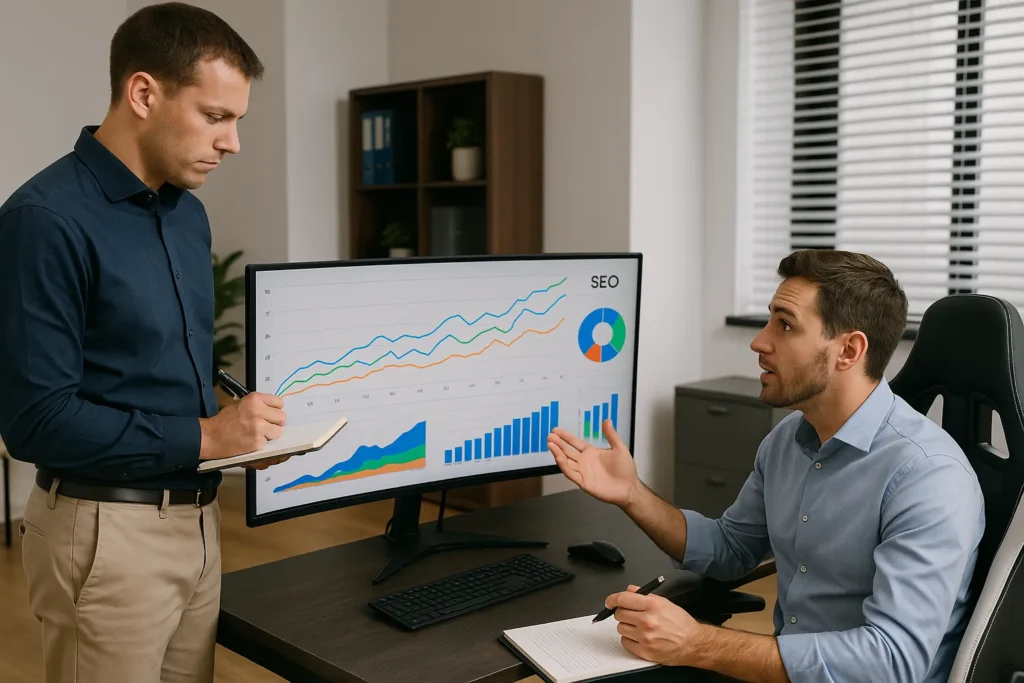Google launched 4,725 changes to search in 2022, which means Google Search changes 13 times per day on average. Yet the websites that consistently rank well follow the same core principles. To future-proof your SEO strategy for algorithm changes, focus on Google’s unchanging fundamentals: user experience, high-quality content, and technical excellence.
The most effective approach combines understanding Google’s algorithm priorities with creating helpful content that serves your target audience. When Google algorithm updates hit, sites following these principles typically maintain or improve their search rankings.
In this guide, we’ll cover the necessary framework for building algorithm-resistant SEO performance, proven tactics for adapting to Google’s updates, and practical steps to implement these strategies regardless of your budget or technical expertise.
Let’s dive into what works in SEO in 2025.
Why Traditional SEO Strategies Are Failing in 2025
Traditional SEO strategies are failing in 2025 because they were based on gaming the system. Google now prioritises things that are difficult to fake: UX and genuine value.
The main causes behind this failure are the anxiety-driven reactive approaches to algorithm updates and the stubborn focus on keywords rather than user intent.
Let’s break down exactly what’s going wrong and why.
The Algorithm Update Anxiety Epidemic
The worst nightmare of any SEO specialist or site owner is to wake up and find that their Google ranking has dropped dramatically. We’ve seen entire industries panic when Google’s helpful content update rolled out, simply because they were creating content for search engines instead of real people.

You know that feeling when you’re still using a flip phone while everyone else has smartphones? That’s exactly what’s happening with old-school SEO tactics (like keyword stuffing and buying random backlinks).
The smartest SEO teams we work with have shifted from reactive to proactive. Instead of scrambling after each Google algorithm update, they focus on what Google consistently rewards: genuinely helpful content that answers user intent.
The Shift from Keywords to User Intent
Remember when you could rank by mentioning your keyword 15 times in a 500-word article? Those days are dead and buried. Google’s algorithm now understands context, synonyms, and what users actually want (thanks to advances in semantic search and machine learning).
What’s fascinating is that Google’s overviews have made this shift even more obvious. When you search for “best pizza near me,” Google doesn’t just look for pages that repeat those exact words. It understands you want recommendations, reviews, locations, and probably opening hours too.
The websites winning in 2025 create content that naturally covers all aspects of what users need, not just what they type into the search box.
Understanding Google’s Core Ranking Principles That Never Change
Google’s core ranking principles that never change are user experience, content quality, and expertise signals: fundamentals that have remained consistent since Google’s inception, despite thousands of algorithm updates.
Search engines get smarter every year, but they still reward the same basic things. Master these fundamentals, and you’ll have a strategy that works regardless of what Google changes next
Now, let’s find out what these unchanging principles look like in practice.
The Foundation of Future-Proof SEO
Most SEO advice changes monthly, but Google’s fundamental mission has remained the same since 1998: to organize the world’s information and make it universally accessible. This mission drives every decision they make.
This is where the E-E-A-T framework (Experience, Expertise, Authoritativeness, Trustworthiness) forms Google’s blueprint for evaluating content quality. We’ve seen websites that master E-E-A-T maintain stable search rankings even when competitors get hit by major updates.
The interesting part is how Google’s own quality guidelines explicitly state that these factors have been consistent across all major updates. Google keeps improving how it spots expertise, but it always rewards sites that demonstrate real knowledge.
Beyond expertise, user satisfaction signals follow the same pattern. Google rewards web pages that keep users engaged and provide genuine value. The metrics might evolve (from bounce rate to dwell time to user engagement), but the principle remains rock-solid.
The Universal Truth About Search Intent
Think about how you use Google search in your daily life. When you search for “how to fix a leaky faucet,” you want step-by-step instructions, not a philosophical essay about plumbing history. Google knows this, and its algorithm prioritizes content that matches what users truly need.
This explains why understanding search intent beats keyword research every single time. You can stuff your content with perfect keywords, but if you fail to solve the user’s actual problem, you fight an uphill battle.
The three types of search intent are informational, navigational, and transactional. They have remained unchanged since search engines existed. Google’s ability to detect and reward content that serves each intent properly has improved dramatically.
The pattern here is clear: successful websites in 2025 solve problems through their content. That universal truth survives every algorithm update.
Building Your SEO Strategy 2025 Framework
An effective SEO strategy for the 2025 framework combines technical excellence, content authority, user experience optimization, and adaptive link building into a cohesive system that responds to changes while maintaining core stability.
This framework works because it addresses all aspects of how search engines evaluate and rank content. Let’s break this into a proven system that works regardless of what Google throws at you next.

The 4-Pillar Future-Proof Foundation
Building a resilient SEO strategy requires four interconnected pillars that support each other and create long-term stability.
Pillar 1: Technical Excellence
Your technical foundation determines whether search engines can effectively crawl, understand, and index your content. This includes mastering core web vitals, mobile-first indexing, and site architecture that scales with your growth.
Site speed improvements alone can boost your organic search performance by up to 20%. We recommend starting with Google’s PageSpeed Insights to identify your biggest technical opportunities.
Pillar 2: Content Authority
Don’t just pump out random blog posts and hope for the best. You need to become the go-to expert in your field by covering topics thoroughly and showing you actually know what you’re talking about.
This means creating informative content that answers every question your target audience might have about your industry. The goal is to become the go-to resource that other websites naturally want to reference and link to.
Pillar 3: User Experience Optimization
User experience signals now carry significant weight in search rankings. Google tracks how people interact with your web pages and uses this data to determine content quality and relevance.
So, focus on improving dwell time, reducing bounce rates, and creating intuitive navigation. When users spend more time engaging with your content, Google interprets this as a quality signal.
Pillar 4: Adaptive Link Building
Quality backlinks remain important, but the approach has evolved. Instead of chasing any link possible, focus on building authority through strategic backlinks that genuinely enhance your credibility.
Brand mentions and relationships are important these days. Create stuff worth talking about and connect with other website owners who actually care about what you do.
How to Adapt to Google Algorithm Updates
To adapt to Google algorithm updates, set up monitoring systems to detect changes early and create response protocols for quick recovery. Focus on studying websites that benefit from updates rather than just those that get penalised.
The difference between websites that thrive and those that struggle comes down to preparation. Here’s how to stay ahead of the curve:
The Early Warning System
Why do some websites seem to predict algorithm changes while others get blindsided? The answer lies in setting up proper monitoring before you need it.
Necessary Monitoring Tools:
- Google Search Console for performance tracking and alerts
- SEMrush Sensor for volatility detection
- Mozcast for temperature readings of algorithm activity
- Custom alerts for sudden traffic drops or ranking changes
We recommend checking these tools weekly, not daily. Daily monitoring creates unnecessary anxiety, while weekly reviews give you enough data to spot meaningful patterns.
The key insight most people miss: algorithm volatility often appears 24-48 hours before official announcements. That’s why we recommend setting up alerts for sudden changes in search results, not just your rankings.
The Rapid Response Protocol
When Google algorithm updates hit, you have roughly 72 hours to assess the impact and determine your response strategy. Panic leads to poor decisions, but having a clear protocol keeps you focused.
Your 24-Hour Assessment Checklist:
- Check if traffic drops affect multiple pages or just specific ones
- Analyse whether the changes target your entire site or specific content types
- Review what types of search results are now ranking in your place
- Compare your performance against direct competitors
Emergency vs. Wait-and-See Situations:
- Take immediate action if: Traffic drops exceed 30%, multiple pages lose rankings simultaneously, or you notice manual actions in Google Search Console
- Wait and monitor if: Changes affect fewer than 10 pages, rankings fluctuate but don’t crash, or the update rollout is still in progress
How to Create SEO Content That Ranks Long-Term
To create SEO content that ranks long-term, focus on solving real problems for your audience while building topical authority through comprehensive, expert-driven content.
Think about it this way: when you search for something online, you want the best answer, not the most keyword-stuffed page. Google knows this, which is why its algorithm rewards content that genuinely helps people.

Here’s what actually works:
- Start with your audience’s real questions: What keeps them up at night? What problems are they trying to solve? Create content that addresses these specific needs rather than guessing what might rank.
- Build expertise around 3-5 core topics: Don’t try to cover everything. Pick the areas where you have genuine knowledge and become the go-to resource. This approach builds topical authority that Google recognises and rewards.
- Write comprehensive guides, not thin content: When you cover a topic, cover it thoroughly. Long-form content consistently outperforms short articles because it provides more value and keeps people engaged longer.
- Update your existing content regularly: Google loves fresh, accurate information. Set aside time monthly to review and improve your top-performing pages with new data, examples, or insights.
- Make it easy to read and navigate: Use clear headings, bullet points, and short paragraphs. If people can’t quickly find what they’re looking for, they’ll leave (and Google notices this behavior).
- Optimize the technical basics: Write descriptive title tags and meta descriptions, use structured data, and make sure your content loads quickly on mobile devices.
The bottom line? Google’s algorithm changes, but user needs remain consistent. Create content that solves problems, and you’ll build an audience that keeps coming back regardless of what updates Google releases.
What Is Technical SEO and Why Does It Matter?
Technical SEO is the foundation that makes your website crawlable, indexable, and user-friendly for both search engines and visitors. It includes site speed optimization, mobile responsiveness, and proper site structure.
Here’s the thing about technical SEO: it’s like the foundation of your house. You might not see it, but without it, everything else falls apart. The good news is you don’t need to be a developer to get most of this right.
Focus on these core areas:
- Make your site mobile-friendly: Over 60% of searches happen on mobile devices, and Google uses your mobile version for ranking. Test your site on your phone right now. Does it load quickly? Are buttons easy to tap? If not, fix this first.
- Improve your page speed: People expect sites to load in under 3 seconds. Use Google PageSpeed Insights to identify what’s slowing you down. Often, it’s just oversized images or too many plugins.
- Fix your site structure: Create a logical hierarchy where your most important pages are easy to find. Use internal linking to connect related content and help both users and search engines navigate your site.
- Optimize for Core Web Vitals: These measure how fast your content loads, how quickly users can interact with your pages, and whether elements shift around while loading. Think of it as Google’s way of measuring user experience.
- Add structured data: This helps search engines understand what your content is about. It’s like giving Google a roadmap to your information, which can lead to rich snippets in search results.
- Keep your URLs clean: Use descriptive URLs that make sense to humans. Instead of “yoursite.com/page123,” use “yoursite.com/technical-seo-guide.”
The technical basics covered here form the foundation that makes everything else possible. Get these right, and you’ll have a solid base that supports your content and user experience efforts. Need more detailed guidance? Check out our technical SEO basics guide for step-by-step instructions.
How to Measure SEO Success and Track Performance
Measuring SEO success comes down to tracking the metrics that matter to your business: quality traffic, relevant keyword rankings, and conversions.
We’ll walk you through five simple steps to track your SEO progress: checking traffic quality, monitoring keyword rankings, watching user behavior, measuring conversions, and setting up alerts for problems.
Step 1: Focus on Traffic Quality Over Quantity
Getting excited about huge traffic spikes feels great until you realise those visitors aren’t sticking around or buying anything. We like using Google Analytics to see which pages bring in visitors who genuinely engage with your content.
Month-over-month growth patterns give you better insights than daily fluctuations, which can make you anxious for no good reason.
Step 2: Track Keywords That Make Sense for Your Business
When you open Google Search Console, you’ll see which search terms bring people to your site. We recommend focusing on keywords that relate to what you’re selling. High-volume vanity terms might look impressive, but they won’t pay your bills.
Your positions will change over time, and that’s completely normal. Small drops happen to everyone.
Step 3: Watch How People Behave on Your Site
Here’s something most people overlook: how long visitors stay on your pages reveals everything about your content quality. When people leave immediately, your content probably isn’t matching their expectations.
The pages where people stick around and explore? Those are your goldmines. Study what makes them work and create more content like that.
Step 4: Track What Brings in Revenue
Traffic looks good in reports, but conversions are what matter for your business. Setting up goals in Google Analytics helps you see when visitors become customers, join your email list, or download your resources.
If your organic visitors aren’t converting, you might be targeting the wrong people or your content needs work.
Step 5: Create Your Safety Net
Nobody wants unpleasant surprises about their website performance. We suggest setting up alerts for major traffic drops or ranking changes so you can investigate issues while they’re still manageable.
Catching problems early makes them much easier to fix.
Budget-Friendly SEO Strategies for Small Businesses
Budget-friendly SEO strategies for small businesses focus on high-impact, low-cost optimizations like improving existing content, building local citations, and using free SEO tools.
Start with what you already have. We suggest auditing your existing content first. Often, you’ll find pages that need minor updates to rank better rather than creating everything from scratch.
Focus on local SEO if you serve customers in specific areas. Claim your Google Business Profile and ensure your business information is consistent across all online directories. This costs nothing but drives valuable traffic.
From our experience, the biggest wins come from optimising your best-performing pages. Use Google Search Console to identify pages ranking on page 2 for important keywords, then improve them with better content and internal linking.

Free SEO tools can handle most of your needs. Google Search Console shows your search performance, Google Analytics tracks your traffic, and Google PageSpeed Insights identifies technical issues. You don’t need expensive software to get started.
We recommend starting with one area and mastering it before moving to the next. Pick either content optimization, local SEO, or technical improvements, then focus there for 2-3 months. This approach prevents overwhelm and delivers better results than trying to do everything at once.
Your Next Steps to SEO Success
Building a future-proof SEO strategy comes down to three core principles: create helpful content that solves real problems, maintain solid technical foundations, and prioritise user experience over quick wins.
The SEO landscape will keep changing, but websites that focus on user value consistently outperform those trying to game the system. Start with the basics, track what matters to your business, and adapt as needed.
Ready to implement these strategies? Check out our comprehensive SEO resources for detailed guides and expert support.



